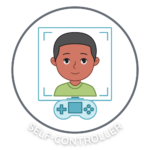Download 30+ Printable Social Skills Posters
Ready-to-use visuals for emotional regulation, self-advocacy, and more

Self-regulation is a fundamental skill for elementary students. Learning to manage emotions and behaviors helps students succeed academically and socially. Everyday Speech offers an innovative tool called the Self-Controller Scanner, an interactive goal poster that guides students through self-regulation strategies. This blog post will explore how elementary special education teachers can use this Interactive Visual Tool to Teach Self-Control Strategies effectively.
Why Self-Regulation Matters
Teaching self-regulation is crucial for students because:
- It Enhances Emotional Intelligence: Helps students understand and manage their emotions.
- It Improves Academic Performance: Reduces disruptions and enhances focus.
- It Builds Social Skills: Encourages positive interactions and conflict resolution.
- It Promotes Overall Well-Being: Helps students develop healthy coping mechanisms.
Introducing the Self-Controller Scanner
The Self-Controller Scanner is an interactive goal poster designed to teach students self-regulation strategies. By following the poster, students learn to scan their bodies and brains, choose a calming strategy, and take steps to regain control. This engaging and visual approach makes learning self-regulation accessible and fun for young learners.

Lesson Plan: Using the Self-Controller Scanner
Objective
By the end of the lesson, students will be able to identify their emotions, choose appropriate calming strategies, and implement steps to regain self-control.
Materials Needed
- Access to Everyday Speech’s Self-Controller Scanner
- A computer or tablet
- Printable emotion cards
- Reflection journals (optional)
Duration
30 minutes
Activity Steps
1. Introduction to Self-Regulation (5 minutes)
Begin by discussing the concept of self-regulation with the students. Explain how recognizing and managing their emotions can help them feel better and interact positively with others. Use simple language and relatable examples, such as feeling frustrated when a game doesn’t go as planned.
2. Introducing the Self-Controller Scanner (5 minutes)
Introduce the Self-Controller Scanner to the class. Explain that this interactive poster will help them learn how to scan their bodies and brains, choose a calming strategy, and take steps to regain control.
3. Guided Practice with the Scanner (10 minutes)
Have the students sit comfortably and guide them through the steps of using the Self-Controller Scanner. Use the printable emotion cards to help them identify how they are feeling.
Example Steps:
- Scan Your Body and Brain: Ask students to think about how their body feels and what is going on in their mind. Are they tense? Are their thoughts racing?
- Choose a Calming Strategy: Provide a list of calming strategies such as deep breathing, counting to ten, or taking a short break. Discuss which strategies might work best for different emotions.
- Take Steps to Regain Control: Guide students to practice their chosen calming strategy and notice how it affects their feelings and behavior.
4. Group Discussion and Reflection (10 minutes)
After the guided practice, gather the students for a group discussion. Ask questions like:
- What did you learn about your emotions today?
- Which calming strategy did you choose and why?
- How did it feel to use the Self-Controller Scanner?
Encourage students to share their thoughts and experiences. If using reflection journals, have them draw or write about their experience with the scanner.
Unlock all of our Self-Regulation materials by signing up for your free trial today – no credit card required!
Access the full Social Communication Curriculum HERE!
Instant access to thousands of no-prep social skills activities, over 1000+ video lessons, and engaging games designed to enhance learning and development.
Conclusion
Teaching elementary students self-regulation strategies is essential for their emotional and social development. Using Everyday Speech’s Interactive Visual Tool to Teach Self-Control Strategies, teachers can create an engaging and interactive learning experience that helps children understand and manage their emotions. By following the provided lesson plan and incorporating the no-prep activity ideas, educators can support their students in building these essential skills. For more resources and tips on teaching social-emotional learning, stay tuned to our blog.
Sample Video
Try out this sample animated video lesson.
We offer our entire Social-Emotional Learning platform free for 14 days here!
Related Blog Posts:
Free Elementary Conversation Topics Material
Promote Social Understanding in Elementary Students with Educational Videos
Enhance Social Skills in Elementary Students with Free Video Resources





